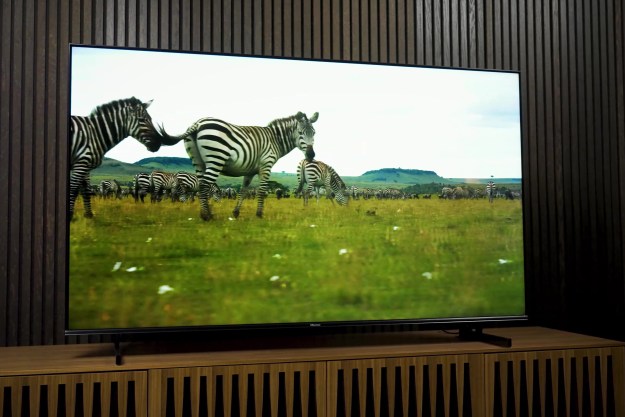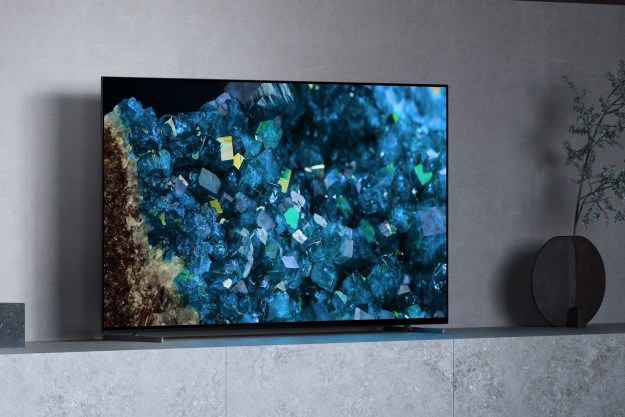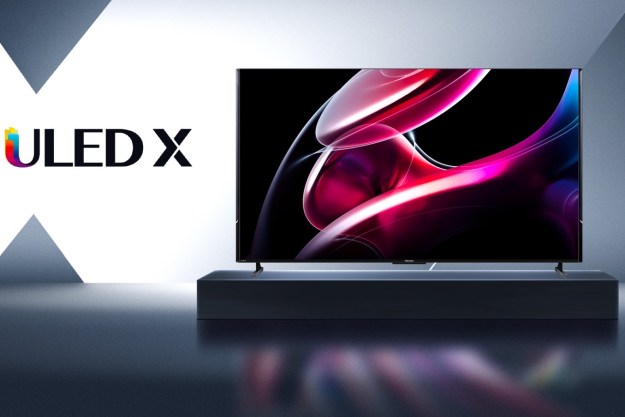
- Effective HDR contrast and color
- Very good backlight control
- Excellent anti-glare
- Great for gaming
- Poor off-angle viewing
I think I found it. I think I found the sweet spot for TVs for 2023. And it’s the Hisense U7K ULED.
I admit I had some pretty high hopes for this TV going into this review. Not lofty expectations, just high hopes. And I’m pleased to report my hopes have not been dashed.
Video review
The Hisense lineup and price comparison
We’ll start with a quick refresher on where the Hisense U7K stands in Hisense’s TV lineup — and the TV market in general. In Hisense’s lineup, there’s the UX, which is the limited edition, cost-no-object TV.
But for most folks, the real flagship of Hisense’s TV lineup is the U8K, and this U7K sits just below that. You might compare the U7K to TCL’s Q7, for example. It’s kind of an upper-midlevel TV. Or you could say it’s a lower-level top-tier TV. You know how there’s a pretty fine line between a medium-rare and medium steak? This TV treads a similar fine line.
| Size | U7K | U8K |
| 55 inches | $550 | $800 |
| 65 inches | $750 | $1,100 |
| 75 inches | $1,000 | $1,600 |
| 85 inches | $1,700 | $2,000 |
Now, a quick comparison based on prices at the time of publishing, though these will likely vary a bit over time. Above is a breakdown of the Hisense U7K prices at various sizes next to the step-up Hisense U8K prices at those same sizes. Generally speaking, you can choose to get a larger U7K for the same price as the step-down size of the U8K. So, the 65-inch U7K costs about the same as the 55-inch U8K, and so on. Or, you could just look at it from the perspective that the U7K is just a more affordable than the U8K.
I mention this because we’ll talk a little about whether, given your budget, you might be better off getting a larger screen U7K or a smaller screen U8K.
Design and specs
The U7K sports an attractive design with surprisingly solid build quality that you don’t see that often at this price. It has a stamped metal back and solid feet that you can position wide — as we have them in our photos — or more narrowly if you have a smaller stand. The TV comes with a backlit remote, and it’s got a fairly robust speaker system built in, with a subwoofer on the back to add some bass to the rather small down-firing speakers built into the bottom of the chassis. For the price, I think you get a fairly attractive TV.
Like its cousins, the U7K is running Google TV.
Let’s correct some misinformation I’ve heard out there around the U7K across various regions globally: The U7K in North America is not the same as the U7K you’ll get in the U.K., Europe, Australia, or New Zealand. The variation in specs and performance for the U7K is less than it used to be, but the TV I’m reviewing is probably a bit higher performance than what you’ll get elsewhere, so keep that in mind. There are other differences, too. For instance, the U.K. version has a different stand and different remote. If you’ve heard that Hisense has unified specs for its TVs across global regions, that is not accurate information. The disparity is reduced, but it’s still there.
Picture quality
Let’s dive into this TV’s picture performance in the segment I like to call Numbers for Nit Nerds. I took most of my measurements from the TV’s filmmaker mode preset in both SDR and HDR. This time, I used the default color temperature setting of Warm 1 and worked from there, because that’s how the TV is set up out of the box. Some of these measurements are a bit different if you select Warm 2, but as I’ll soon discuss, things looked pretty solid before I did any tweaking.
White balance and color accuracy
The white balance in SDR Filmmaker mode was damn good for a TV at this price. Errors were mostly in the bright white areas, with the white trending a little too cool, or blue. It was an easy fix by knocking the blue gain down in the 2-point white balance, which resulted in outstanding results. It was the same for the HDR white balance, which, by the way, must be adjusted separately.
Color accuracy out of the box was very good for SDR and outstanding for HDR. The only rogue colors are green and cyan, and those weren’t significantly out of whack, according to the numbers. The brighter those colors got, the more they strayed from accuracy. But the errors are low enough that most folks will rarely, if ever, pick up on them. I saw 97% of the P3 color gamut and 76% for BT.2020, and the only notable color errors were at the brightest end of the spectrum. That’s outstanding performance for a TV of this price.
Brightness
Now, for everyone’s favorite part: peak brightness. Interestingly, in SDR Filmmaker Mode, the peak brightness out of the box was about 530 nits — and that’s at about 80% on the brightness setting. That’s way too bright for the Accuracy Police. But for most folks, that kind of SDR brightness is gonna be exactly what they want, so while it doesn’t seem to fit the intention of Filmmaker Mode, it’s a smart move for making customers happy.

You can pull the brightness down for SDR if you watch in a dark room — or you can use the embedded light sensor to make those adjustments based on how bright or dark your room is. But I need to make a big deal out of this: If you want the best brightness this TV can provide, you really need to turn that light sensor off. I found that while it does a decent job of adjusting the brightness depending on your room, it messes around with the white balance in a way I don’t care for. So I turn it off and leave it off.
The story around peak brightness in HDR is kind of interesting. In case you’re new to my TV reviews, Hisense TVs historically outperform their claimed peak brightness. That was true of the U7G and U8G two years ago. It was true last year with the U7H and U8H. And it was even true of the U8K we reviewed earlier this year. For instance: Hisense would print 1,000 nits peak brightness on the box, and the TV would handily outperform that by punching up to, say, 1,300 nits.

That has not been the case for me with this specific U7H TV sample, but I think I have an outlier here. My readings for peak brightness in HDR with a 10% white window came in at around 750 nits. And when I moved the test pattern to a 25% window, it bumped up to 850 nits.
That’s short of Hisense’s claim of 1,000 nits — as I said, I expected the TV to outperform Hisense’s claims. Ditching the white window for the Spears & Munsil peak HDR highlight pattern, I saw about 600 nits.

Now, I normally don’t do this, but I checked a few other reviews from reviewers I respect, and they were right at about that 1,000-nit peak on their test bench. I’ve rooted around in all the settings and made sure no eco or power saving settings were on, that the local dimming is set to high as it should be, and I even toggled dynamic tone mapping on and off just to see what happened. This sample is just not as bright as those I’m seeing reviewed elsewhere. I don’t think there is anything wrong with the TV, I just think that’s how this sample behaves. Hisense tells me they also think this sample is an outlier, for what it’s worth.
I’m not too worried about it, though, because perceptually, there’s not a ton of difference between 850 nits and 1,000 nits. The average picture level of this TV tracks exactly as expected, with about 550 nits of full-field brightness.
Motion and processing
This TV flawlessly performs 3:2 pulldown for judder-free, 24 frames-per-second (fps) movie and TV playback, though there is the predictable stutter in bright areas on slow panning shots due to the TV’s excellent pixel response time. The U7K does have a black frame insertion (BFI) feature and it is, as expected, very flickery and I can’t stand it. But that’s true for almost every TV I review. Still, if you want BFI, it’s available.

Upscaling is very respectable on this TV in general, and great for the price of the TV. It handily outperforms the TCL Q7 in terms of sharpness when upscaling 720p content, though there’s less of a difference from 1080p content. In fact, image processing overall is pretty stellar. You will see some color banding on low-bit-depth sources like YouTube or Sling TV, and unfortunately, the smooth gradation feature doesn’t seem to have much of an effect. I see no improvement with this on low, medium, or high, so I just left it off.
Blooming control is very good. I’d say the TCL Q7 is just slightly better in that one area, but you’d never know it without putting the two side by side. Black levels are generally excellent, and contrast is outstanding for a TV at this price.
Performance
The pros
Now that we’ve got the technical details covered, let’s speak more broadly about this TV’s performance. I’ve lost count of how many hours I’ve spent watching this TV — just normal, everyday content, from TV shows to YouTube, to live sports, to streaming movies and 4K Blu-rays. Here’s the takeaway:
I think the Hisense U7K is the smartest TV buy for most people. I have already recommended it to several friends and a couple of extended family members, and every person who has bought it went out of their way to email or text me to tell me how thrilled they are with their new U7K TV.

The U7K’s performance is good enough to satisfy a video enthusiast on a tighter budget, and far better than most folks will be expecting when they take it home. It offers awesome color accuracy out of the box — so long as you use Filmmaker Mode or Theater Day or Night. It retains HDR highlights well – this TV rolls off gently, it does not hard clip. It’s brilliant and vibrant for all kinds of content. It upscales your cable, satellite, or DVD collection well, and the user interface is solid and reliable — at least for now.
The motion resolution is quite good on this TV. I watched a lot of fast-moving sports, and I was never disappointed with quick camera moves up and down the basketball court or football field. Movies looked great. TV shows were flawless.
It is, in my opinion, the best value in TV.
The game mode is excellent on this TV. Game mode picture performance is really not all that far off from more accurate picture modes, plus it offers a fun gaming dashboard and supports FreeSync VRR and refresh rates up to 144Hz if you’ve got a PC that can support that. And it even sounds pretty decent, considering most TV speakers just sound downright awful.
The TV just ticks all the right boxes. It is, in my opinion, the best value in TV. It hits that sweet spot of performance and price. You can pay more, but you won’t get a lot more. And you can pay less, but you will get a lot less than this TV offers. I mean, that’s why I’m going to make this a go-to recommendation to anyone who is not a nit nerd.
The cons
The TV is not perfect, though. While it has outstanding anti-reflection on it, which minimizes glare, and is a good TV for daytime viewing where you have some sun coming into the home, the off-angle viewing is not good. Now, to be fair, most TVs at this level and even above this level don’t have good off-angle performance. The second you step off from dead center in front of this TV, the contrast and color start washing out. But again, that is par for the course. Hisense could improve the off-angle by using an IPS panel, but the black levels, blooming, and halo issues would take a small hit. Speaking of which, I believe the 75-inch version of this TV does use an IPS panel – so it will have better off-angle viewing, and with more dimming zones. Its black levels and blooming control should still be pretty good, even with an IPS panel – perhaps just not as excellent as we see on the 55-inch and 65-inch models.

Also, this TV – and this may just be a bug, I’m checking with Hisense – kept reducing the peak brightness to 78 in HDR via HDMI sources. I can’t figure out why.
The bottom line
If you’ve been wondering if maybe the Hisense U7K might be the right TV for you, I 100% throw my full weight behind this TV. It has been great to live with this TV for a couple of weeks, and I think most of you are going to love it.
Now, for those of you who consider yourself a more casual nit nerd – like you enjoy the company, but you’re not a card-carrying member – you might be wondering if you are better off getting the U7K or the U8K. And to anyone who is having a tough time deciding between the two, here’s what you need to know:

The U8K is a brighter TV. It has a brighter average picture level, and its HDR highlights are also brighter. It’s got a bit more punch to it, and when there’s more ambient light, it can maintain the perception of contrast and color vibrancy just a bit better than the U7K. If you watch during the day a lot, and you want the best possible experience when watching during the day, then I think the U8K is worth the upgrade.
But for most folks, including would-be TV enthusiasts who do most of their watching in a dim-to-dark room, or can at least make it dim or dark when they want, the U7K is all you really need. It’s such a delightfully, surprisingly great TV. It’s better than the TCL Q7, and while not as great as the TCL QM8, it gets mighty close for a lot less money.
My final message to you is: Buy with confidence. The Hisense U7K gets two thumbs up from me, and I’m looking forward to recommending it to most folks who call for TV buying advice.
Editors' Recommendations
- Best Walmart TV deals: 43-inch 4K TV for $195 and more
- TCL’s giant 115-inch QM89 is the world’s largest 4K mini-LED TV
- Mini-LED vs. QLED TV: how one technology is improving the other
- Hisense kicks off its U8K mini-LED TV availability with deep discounts
- Hisense’s mini-LED U6K TV arrives, starting at $500












